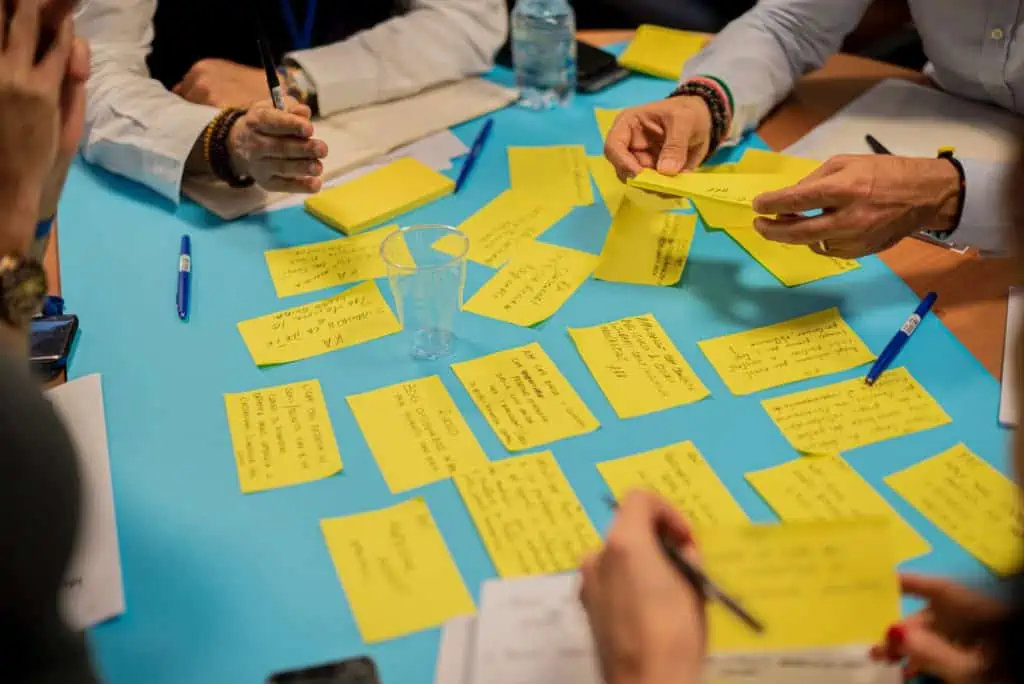Interviewing entrepreneurs, I have found that while their ideas have come in multiple ways, in multiple places, their success comes from the ideation process.
Writers can afford to be more of the back of a beer mat school of ideation, a quick scribble of a nugget that strikes when driving or in the bath. We then go and shut ourselves away and start to test it out, develop it straight onto paper. The leap from idea to functioning company is a little larger.
The genius of entrepreneurs lies in a combination of idea generation, or market gap identifying and their ability to develop that idea into a viable business. For golden lightning moments of inspiration, one of my favorite examples remains the stroy of American serial entrepreneur, Jeff Fenster who was one of the contributors to Scale for Success.
Challenging the Norm
Jeff was running low on patience one day, attempting the ongoing battle that many a parent knows, trying to persuade his daughter to eat her vegetables and not go straight to her whip desert. When his patience finally ran out, Jeff upended aforesaid frozen desert into the courgettes without stopping to consider what he was doing. Not only did his daughter love it, but out of the frozen health food mix came the menu for a chain of fast-food restaurants called Everbowl, now sweeping across southwest America, Everbowl.
However, not everyone gets hit by such a bolt of genius, and you may need to use design-led thought processes to come up with your business idea. In doing so, and then when working with your team, ideation will be part of that process. As a leader, it will be your job to facilitate it to enable your team to come up with the best results. Ideation needs empathy, understanding, and people skills.
The d-school at Stanford University teaches ideation, starting in the field, listening to your users, understanding their needs. Using observation and interviews, you gain clarity about their problems from effective gathering and analysis of data. From that, you construct an actionable problem statement, or POV (point of view) describing what the base challenge is and what the user needs.
It is easy to make assumptions about what the problem is. Jeff Fenster talks of how people think of needing gum or cologne to remove the smell of smoke when the real issue is helping the smoker stop smoking.
Effective ideation is all about challenging assumptions and the answers we think we know. Children have been encouraged, eat vegetables for generations, but if you had raised a discussion about mixing vegetables into a frozen pudding, people might have queried the wisdom unless it was in a massively creative brainstorming session.

Continuing the Ideation Process
Once you have formed a POV, understand what people need and why, the process starts to come together and the challenge can then be broken down into actionable sections, and each one examined, and solutions thought up and examined.
There are various techniques to open up your team’s thinking, and it will be a question of trial and error to find the right ones to suit you and your team. If they are not naturally creative thinkers, they will need more encouragement. Everyone, however, needs a safe place where no outlandish suggestions are laughed at, where ideas flow, and the status quo will be challenged.
Good ideation and innovation relies on all team members feeling sufficiently inspired by the challenge, combined with feeling safe where to express their ideas, however out there, and not to be ridiculed. The team leader has a huge role to play in the success of ideation sessions.

A Stanford Challenge
Another entrepreneur I was privileged to talk to when writing Scale for Success is Durell Coleman. While studying at Stanford, his professor asked Durell to list the top 100 problems he would like to solve. It is an extraordinary challenge and one that perhaps every budding entrepreneur should be encouraged to do.
Durrell managed to get to the mid-sixties on problems that impinged on his life, the difficulty of drying clothes in digs, for example. Only when those had run dry did he start naming larger issues. Poverty was number 67, and that inspired him to found DC Design. The list also changed his thinking and started him designing solutions to problems.
Durell is now a Facilitator of Design Thinking and Leadership at Stanford. DC Design also runs an award-winning Design the Future, Design Thinking program. His work is featured in the PBS documentary “Extreme by Design,” used as a teaching aid worldwide. He developed a design orientated process, which is the static centre of the business. The challenges he and his team address change continually, but that human-centred design thought process being at the core never does.
They use the process to address social problems. Examples include the foster care system in Silicon Valley, reducing jail recidivism, designing optimal emergency departments. Every project works with the people involved and impacted instead of data. The only time Durell has come off course in business, he says, is when he came away from that principle.
Durell says you have to decide if the problem is a “hair on fire” problem. This is a way he heard someone else define urgency. You might have your hair on fire, but you also have an itch on your leg, two problems, one that needs solving immediately. The hair on fire problem is the one you need to address, something people really care about. And the solution to that problem needs to be easy.
Understanding Ideation
The ideation phase is where you come up with solutions. Some solutions are simple, but some need work to meet the need. There are always several solutions to a challenge unless we remain blocked, too attached to the status quo solution. You can hold onto the obvious answer but be equally open to ignoring it. “Norms” stultify any ideation process.
Test the idea aalongside every other you have. Once you are sure of the idea, it is forward to prototyping and testing with those people whose problem you want to solve again. Their input is crucial all the way through the thought process. Never forget the people you aim to serve, be it a community or customers.
Some parts of this blog was originally written for Oxford Entrepreneurs


